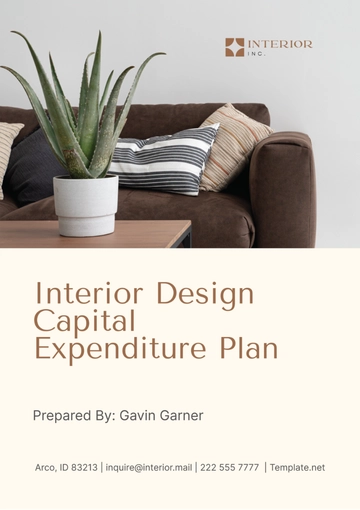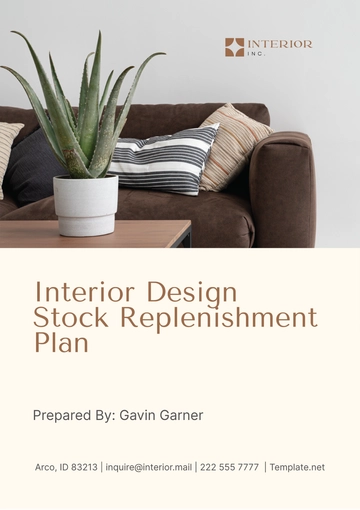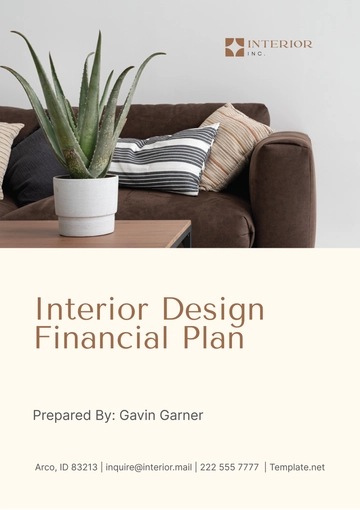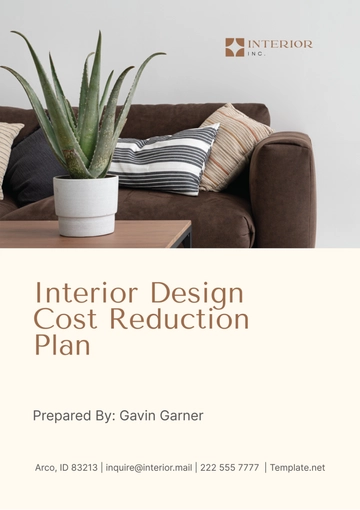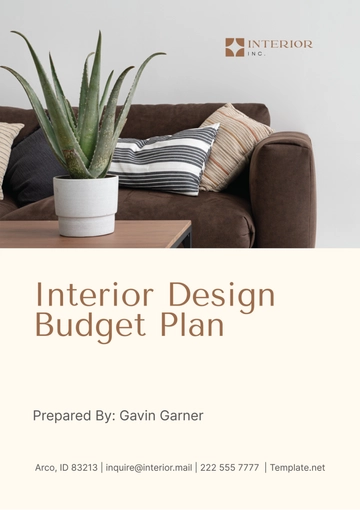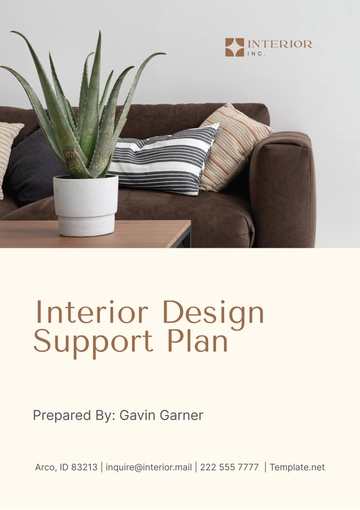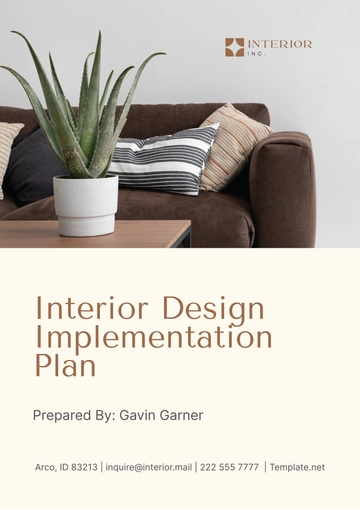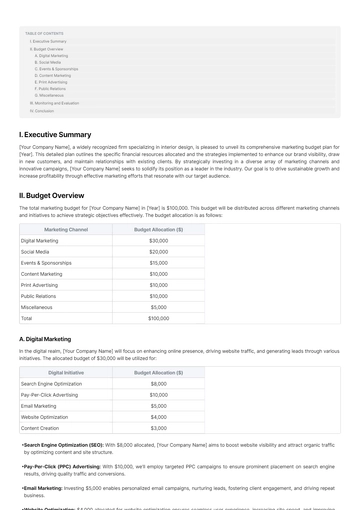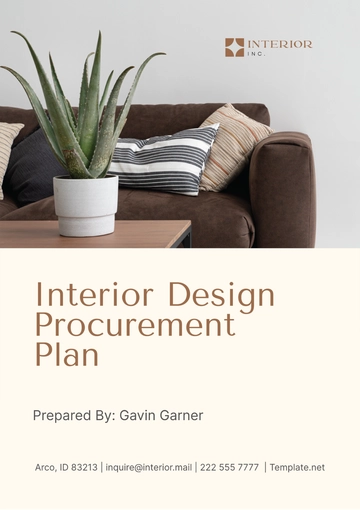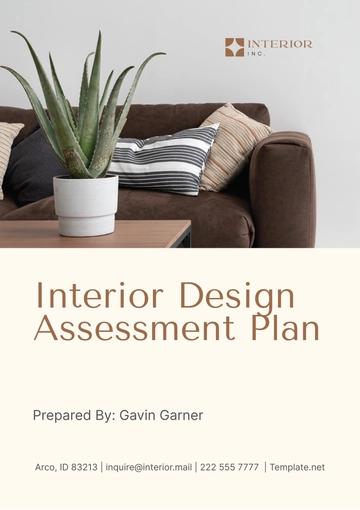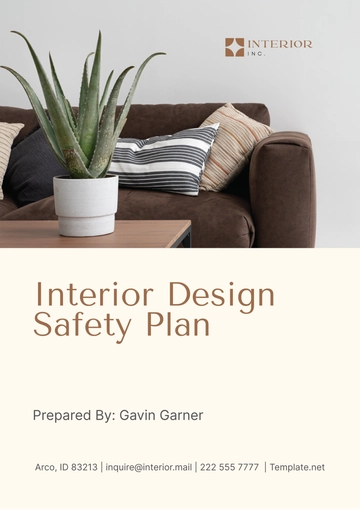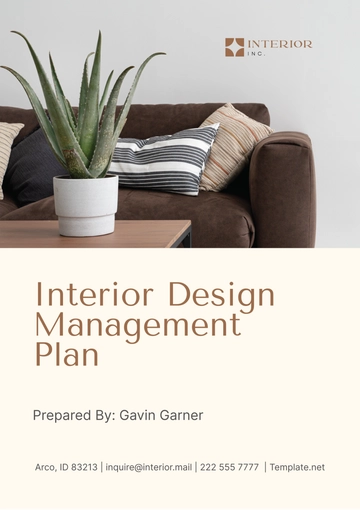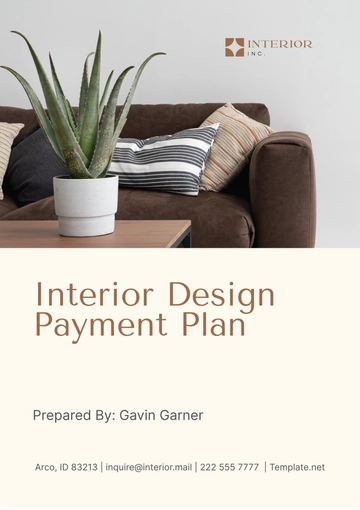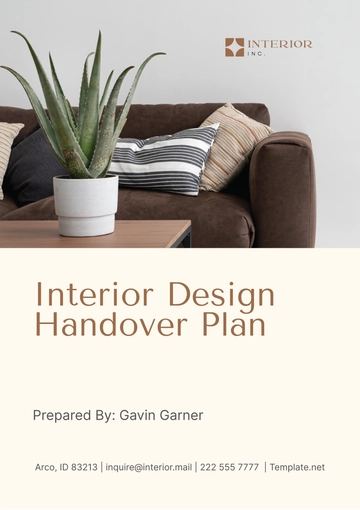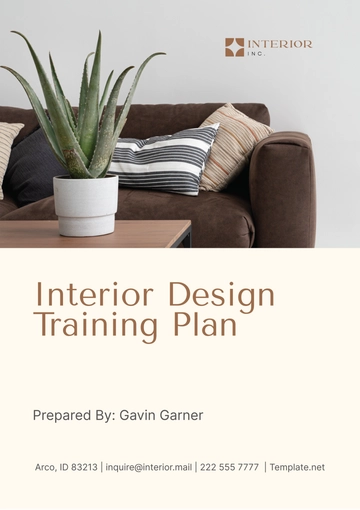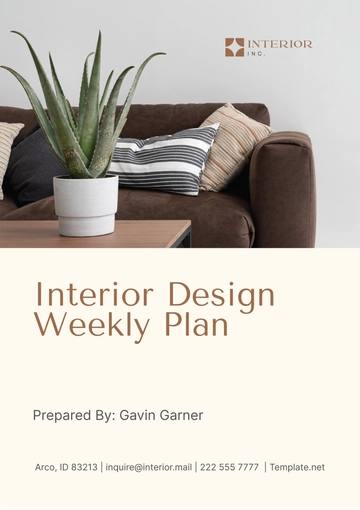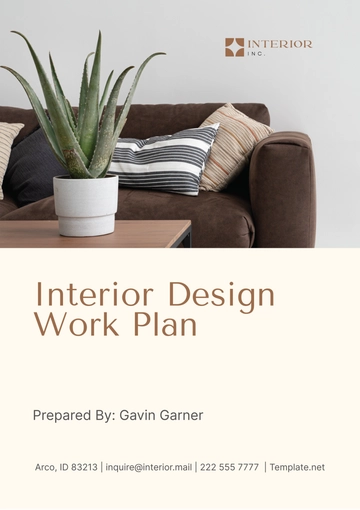Free Interior Design Management Plan
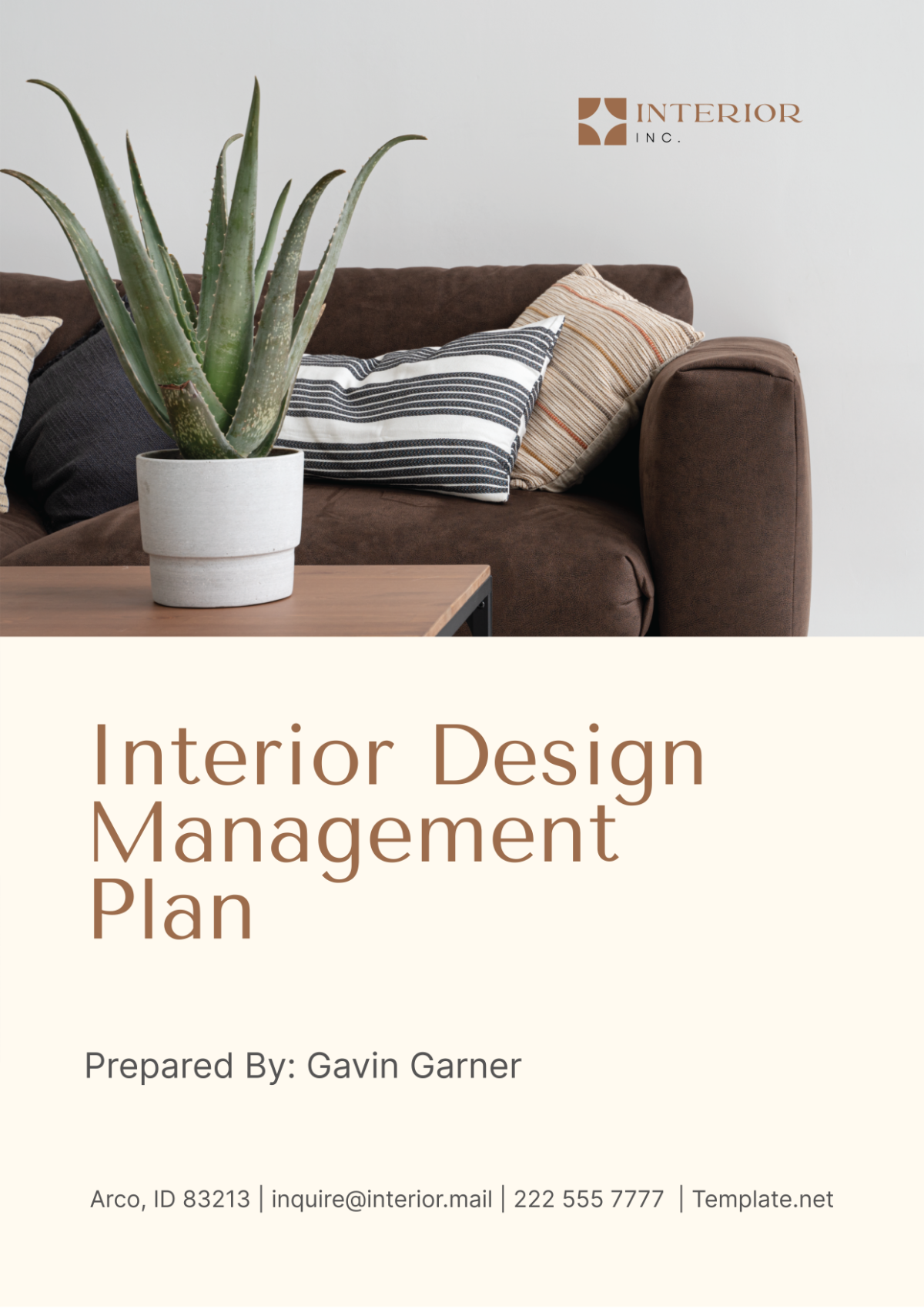
Introduction
This management plan serves as a guide for overseeing interior design projects at [Your Company Name]. It outlines our methodology for ensuring each project is executed efficiently, within budget, and to the highest standards of quality. The plan focuses on strategic planning, resource allocation, client communication, and project delivery.
Project Initiation
Project initiation is the critical first step in our project management lifecycle at [Your Company Name]. This phase is focused on laying a solid foundation for the project through comprehensive client consultations, precise project scoping, and meticulous resource planning. It is designed to align our project objectives with the client’s vision right from the start, ensuring a streamlined process moving forward.
Client Consultation: This involves deep engagement with the client to understand their expectations, preferences, and functional requirements. Through detailed interviews and carefully designed questionnaires, we collect essential information that shapes the project's direction.
Project Scoping: We define clear project goals, deliverables, timelines, and budgets. This step includes creating a project charter that serves as a formal document outlining the project's scope, identifying stakeholders, and setting agreed-upon milestones.
Resource Planning: Effective allocation of resources is crucial. We assign project teams based on expertise and availability, select appropriate technology tools for design and collaboration, and estimate other resource needs, such as materials and equipment, to ensure project readiness and agility.
Design Development
The design development phase at [Your Company Name] is where creativity meets functionality. Here, our skilled team of designers and architects transform the initial client requirements into concrete design concepts and detailed plans. This phase is highly collaborative, involving regular interactions with the client and integration of their feedback to refine and perfect the design.
Conceptual Design: Our design team creates innovative and aesthetically pleasing initial concepts that reflect the client’s style and functional needs. These concepts are presented through visual aids like sketches, mood boards, and digital renderings to provide a clear vision of the potential outcomes.
Design Selection: We engage in a dynamic collaboration process with the client, involving presentations and discussions to refine the designs. Client feedback is integral here, as it guides the evolution of the concepts into the final design that best fits their vision and practical requirements.
Technical Documentation: Once a design is selected, our team develops comprehensive technical documentation, which includes detailed drawings, precise material specifications, and explicit installation instructions. These documents are essential for guiding the subsequent phases of procurement and installation, ensuring accuracy and alignment with the design intent.
Resource Management
Effective resource management is pivotal in achieving the seamless execution of design projects at [Your Company Name]. This section details our approach to strategically allocating and optimizing both human and material resources, ensuring project objectives are met efficiently and within budget constraints.
Human Resources:
To assign tasks based on individual expertise and specific project requirements, ensuring optimal workload distribution and maximizing team performance.
Evaluate project demands and match tasks with team members' skills and career development goals.
Material Procurement:
To source high-quality materials that meet design specifications while adhering to budget constraints.
Negotiate with suppliers to obtain the best prices and terms for materials that meet our quality standards.
Vendor Management:
To establish and maintain relationships with reliable vendors and contractors who can deliver quality services and goods in a timely manner.
Conduct regular performance evaluations of vendors and maintain open lines of communication for continuous improvement.
Component | Objective | Outcome |
|---|---|---|
Human Resources | Assign tasks based on expertise and requirements. | Enhanced productivity and job satisfaction. |
Material Procurement | Source high-quality materials within budget. | Cost-effective procurement without compromise. |
Vendor Management | Maintain relationships with reliable vendors. | Reliable vendor network for smooth execution. |
Client Communication
Open and effective communication with clients is essential for the success of any project at [Your Company Name]. This section outlines our proactive strategies to ensure clients are consistently informed and actively involved throughout the project lifecycle.
Regular Updates: Schedule regular meetings and prepare detailed reports that outline the current status of the project. Clients feel involved and reassured, fostering a trust-based relationship.
Feedback Mechanisms: Implement systems such as feedback forms, regular check-ins, and client surveys. Quick resolution of concerns and alignment of project outcomes with client expectations.
Documentation: Utilize a client-accessible project management tool to share real-time updates and documentation. Transparency and constant accessibility to project details, enhancing client satisfaction.
Quality Control
This critical phase ensures that every aspect of the project—from materials to craftsmanship—adheres strictly to the highest standards of quality. Our rigorous quality control process involves multiple checks throughout the project lifecycle to identify and address any deviations promptly.
Materials Inspection: Prior to use, all materials are inspected to ensure they comply with project specifications and quality standards. This includes checks for durability, color accuracy, and texture, ensuring that only the best materials are used in our projects.
Workmanship Monitoring: Our quality control team conducts regular on-site inspections to monitor the workmanship of all contractors and subcontractors involved in the project. This helps to ensure that all construction and installation processes align with our design intentions and quality expectations.
Compliance with Standards: We adhere to local building codes, environmental regulations, and industry standards to ensure every aspect of our work is legally compliant and sustainable.
Client Involvement: We engage our clients in the quality control process, inviting them to key inspections and reviewing stages to gather their feedback and ensure their vision is being accurately realized.
Final Quality Audit: Before the official project handover, a final quality audit is conducted. This comprehensive review includes a detailed checklist covering every element of the project to ensure nothing is overlooked.
Quality Aspect | Frequency | Responsible Party |
|---|---|---|
Material Quality | Upon delivery and before use | Quality Control Team |
Construction and Installation | Bi-weekly during active phases | Site Supervisor |
Environmental and Legal Compliance | Start and end of the project cycle | Compliance Officer |
Client Satisfaction | At major milestones and at project completion | Project Manager |
Overall Project Review | Prior to client handover | Quality Control Manager |
Project Completion and Evaluation
The completion and evaluation phase is crucial for wrapping up projects and setting the stage for future success. This phase at [Your Company Name] includes client walk-throughs, comprehensive documentation handover, and an in-depth project review to assess performance and gather learnings.
Final Walk-through: We conduct detailed client walk-throughs to ensure every aspect of the project meets or exceeds expectations. During these sessions, we address any final adjustments and confirm that all elements are executed as planned.
Handover Documentation: At the conclusion of the project, we provide all necessary documentation, including detailed maintenance guides and warranty information, to support the client in managing their new space effectively.
Project Review: Our team performs a thorough analysis of each project's performance to identify key successes and areas for improvement. Insights gained from this review are used to refine our processes and enhance client satisfaction in future projects.
Conclusion
The Interior Design Management Plan at [Your Company Name] serves as a blueprint for delivering exceptional design projects that meet our high standards and achieve client satisfaction. This plan outlines our systematic approach to managing all aspects of the interior design process, from initiation through to completion and evaluation. By adhering to this plan, we maintain consistency in our work and uphold our commitment to quality and client-centric service.
- 100% Customizable, free editor
- Access 1 Million+ Templates, photo’s & graphics
- Download or share as a template
- Click and replace photos, graphics, text, backgrounds
- Resize, crop, AI write & more
- Access advanced editor
Streamline project execution with the Interior Design Management Plan Template from Template.net. This template is editable and customizable in our Ai Editor Tool, providing a comprehensive approach to managing all aspects of interior design projects, from timeline planning to resource allocation, ensuring projects are completed efficiently and to high standards.
You may also like
- Finance Plan
- Construction Plan
- Sales Plan
- Development Plan
- Career Plan
- Budget Plan
- HR Plan
- Education Plan
- Transition Plan
- Work Plan
- Training Plan
- Communication Plan
- Operation Plan
- Health And Safety Plan
- Strategy Plan
- Professional Development Plan
- Advertising Plan
- Risk Management Plan
- Restaurant Plan
- School Plan
- Nursing Home Patient Care Plan
- Nursing Care Plan
- Plan Event
- Startup Plan
- Social Media Plan
- Staffing Plan
- Annual Plan
- Content Plan
- Payment Plan
- Implementation Plan
- Hotel Plan
- Workout Plan
- Accounting Plan
- Campaign Plan
- Essay Plan
- 30 60 90 Day Plan
- Research Plan
- Recruitment Plan
- 90 Day Plan
- Quarterly Plan
- Emergency Plan
- 5 Year Plan
- Gym Plan
- Personal Plan
- IT and Software Plan
- Treatment Plan
- Real Estate Plan
- Law Firm Plan
- Healthcare Plan
- Improvement Plan
- Media Plan
- 5 Year Business Plan
- Learning Plan
- Marketing Campaign Plan
- Travel Agency Plan
- Cleaning Services Plan
- Interior Design Plan
- Performance Plan
- PR Plan
- Birth Plan
- Life Plan
- SEO Plan
- Disaster Recovery Plan
- Continuity Plan
- Launch Plan
- Legal Plan
- Behavior Plan
- Performance Improvement Plan
- Salon Plan
- Security Plan
- Security Management Plan
- Employee Development Plan
- Quality Plan
- Service Improvement Plan
- Growth Plan
- Incident Response Plan
- Basketball Plan
- Emergency Action Plan
- Product Launch Plan
- Spa Plan
- Employee Training Plan
- Data Analysis Plan
- Employee Action Plan
- Territory Plan
- Audit Plan
- Classroom Plan
- Activity Plan
- Parenting Plan
- Care Plan
- Project Execution Plan
- Exercise Plan
- Internship Plan
- Software Development Plan
- Continuous Improvement Plan
- Leave Plan
- 90 Day Sales Plan
- Advertising Agency Plan
- Employee Transition Plan
- Smart Action Plan
- Workplace Safety Plan
- Behavior Change Plan
- Contingency Plan
- Continuity of Operations Plan
- Health Plan
- Quality Control Plan
- Self Plan
- Sports Development Plan
- Change Management Plan
- Ecommerce Plan
- Personal Financial Plan
- Process Improvement Plan
- 30-60-90 Day Sales Plan
- Crisis Management Plan
- Engagement Plan
- Execution Plan
- Pandemic Plan
- Quality Assurance Plan
- Service Continuity Plan
- Agile Project Plan
- Fundraising Plan
- Job Transition Plan
- Asset Maintenance Plan
- Maintenance Plan
- Software Test Plan
- Staff Training and Development Plan
- 3 Year Plan
- Brand Activation Plan
- Release Plan
- Resource Plan
- Risk Mitigation Plan
- Teacher Plan
- 30 60 90 Day Plan for New Manager
- Food Safety Plan
- Food Truck Plan
- Hiring Plan
- Quality Management Plan
- Wellness Plan
- Behavior Intervention Plan
- Bonus Plan
- Investment Plan
- Maternity Leave Plan
- Pandemic Response Plan
- Succession Planning
- Coaching Plan
- Configuration Management Plan
- Remote Work Plan
- Self Care Plan
- Teaching Plan
- 100-Day Plan
- HACCP Plan
- Student Plan
- Sustainability Plan
- 30 60 90 Day Plan for Interview
- Access Plan
- Site Specific Safety Plan
